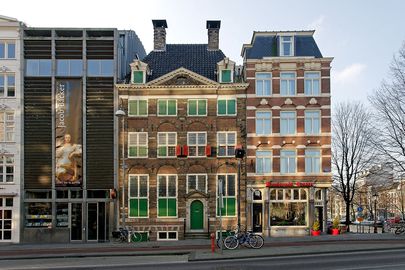

The house where Rembrandt spent almost 20 years of his life between 1639 and 1658 is now one of Amsterdam most interesting museums among the ones not visited by masses of tourists, who tend to flock to the more renown Rijksmuseum and Van Gogh Museum. The neighborhood surrounding Rembrandt's House is the historical Jewish quarter which gave birth to such luminaries as Spinoza.
In the day when Rembrandt's house was built, many rich merchants as well as artists settled in this new part of town. The house is a fairly spacious two-storey dwelling with a stepped gable. In about 1627-28 the house was drastically remodeled. It was given a new façade, a triangular corniced pediment - the height of modernity at the time - and a third storey was added. The reconstruction was probably supervised by Jacob van Campen, who later made the name as the architect of the Amsterdam City Hall, today known as the Royal Palace on Dam Square.
Purchased with an installment loan - an equivalent to today's mortgage - in early 1639, with a downpayment of 1200 guilders, the total cost of this lavish purchase ran up to 13,000 guilders, a substantial sum for that time. Although Rembrandt was the most successful painter in Amsterdam at the time, it wasn't his income that was most instrumental in the purchase. His wife, Saskia van Uylenburgh, came from a socially prominent family and this fact must have carried some weight with the lenders. Most of the initial loan was never repaid and it was mainly this debt that led to Rembrandt's bankruptcy in 1656 and his eviction. In 1658 he was forced to relocate. Extenuating circumstances - including a prolonged financial crisis in the 1650s which arose due to the First Anglo-Dutch War of 1652-54 – also greatly contributed to Rembrandt's bankruptcy. In addition to that, the artist, as the legend goes, always lived beyond his means, certainly while married to Saskia. And after Saskia's death, though he did not have access to her capital, he could still use the interest as a usufruct.
In 1660-62 Rembrandt's former house was shored up and split into two. It was to house several different families up to the end of the nineteenth century. During this period the house was altered several times, and its condition deteriorated over the years. The house might well have been demolished if it not once had such a famous occupant. Action was taken on the occasion of the Rembrandt exhibition in 1906. The City of Amsterdam bought the dilapidated building and shortly afterwards handed it over to the StichtingRembrandthuis, a foundation set up a year later. The trustees of the foundation wanted to return Rembrandt's former home to the state it was in around the middle of the seventeenth century. The envisaged reconstruction did not, however, go ahead. The board opted for a contemporary approach without historical references. The Rembrandt House became the setting for a print collection. A drastic restoration was carried out under the supervision of the architect named de Bazel. The restoration was completed in 1911 and Queen Wilhelmina opened the museum.
The new wing, which was opened on the 7th of May 1998, houses two exhibition galleries, the secretarial department, offices and the library, as well as the Rembrandt Information Centre. Once the new wing was completed, it was possible to resurrect the old plan to restore Rembrandt's former home to its original condition. The inventories of the house were very important. The initial inventory of 1626 belonging to the first occupant of the house and, in particular, the inventory that was compiled after Rembrandt's bankruptcy. This latter source enabled the experts to work out how the house was laid out during this period and how Rembrandt had used the different rooms.
The house is predominantly in the same state now as it was in Rembrandt's time. It features his own art as well as the art of his contemporaries, including 250 out of 300 of his own engravings and etchings. The museum also serves as a venue for creative workshops, lectures and has excellent educational facilities. Practical expert demonstrations on etching and pigment preparation are offered daily.